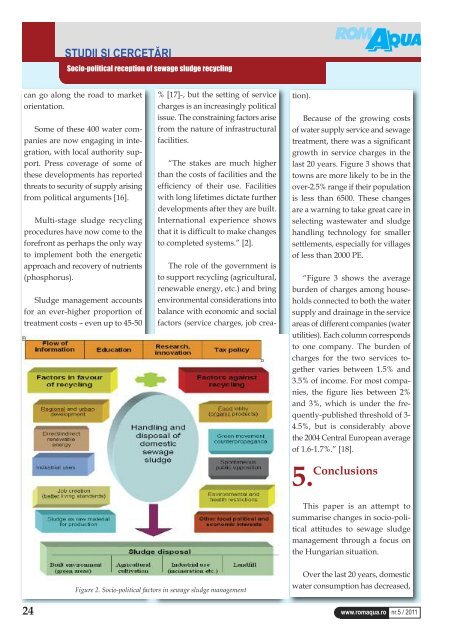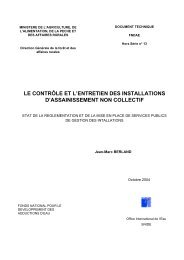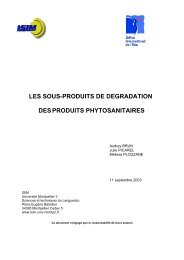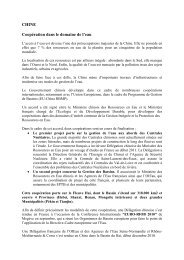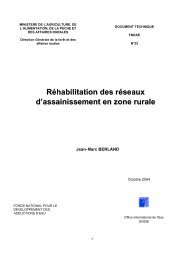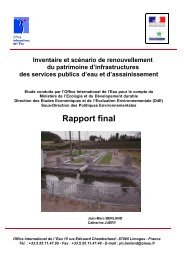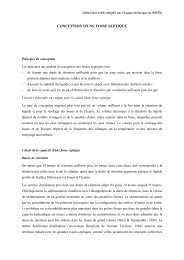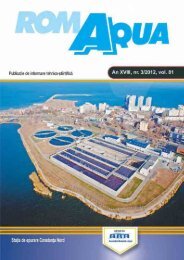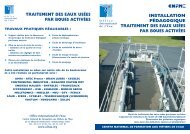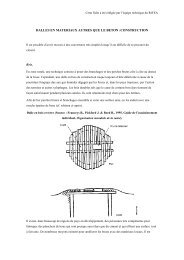vol 77 n° 5 2011 - Office International de l'Eau
vol 77 n° 5 2011 - Office International de l'Eau
vol 77 n° 5 2011 - Office International de l'Eau
Create successful ePaper yourself
Turn your PDF publications into a flip-book with our unique Google optimized e-Paper software.
STUDII ŞI CERCETĂRI<br />
socio-political reception of sewage sludge recycling<br />
can go along the road to market<br />
orientation.<br />
Some of these 400 water companies<br />
are now engaging in integration,<br />
with local authority support.<br />
Press coverage of some of<br />
these <strong>de</strong>velopments has reported<br />
threats to security of supply arising<br />
from political arguments [16].<br />
Multi-stage sludge recycling<br />
procedures have now come to the<br />
forefront as perhaps the only way<br />
to implement both the energetic<br />
approach and recovery of nutrients<br />
(phosphorus).<br />
Sludge management accounts<br />
for an ever-higher proportion of<br />
treatment costs – even up to 45-50<br />
% [17]-, but the setting of service<br />
charges is an increasingly political<br />
issue. The constraining factors arise<br />
from the nature of infrastructural<br />
facilities.<br />
“The stakes are much higher<br />
than the costs of facilities and the<br />
efficiency of their use. Facilities<br />
with long lifetimes dictate further<br />
<strong>de</strong>velopments after they are built.<br />
<strong>International</strong> experience shows<br />
that it is difficult to make changes<br />
to completed systems.” [2].<br />
The role of the government is<br />
to support recycling (agricultural,<br />
renewable energy, etc.) and bring<br />
environmental consi<strong>de</strong>rations into<br />
balance with economic and social<br />
factors (service charges, job crea-<br />
tion).<br />
Because of the growing costs<br />
of water supply service and sewage<br />
treatment, there was a significant<br />
growth in service charges in the<br />
last 20 years. Figure 3 shows that<br />
towns are more likely to be in the<br />
over-2.5% range if their population<br />
is less than 6500. These changes<br />
are a warning to take great care in<br />
selecting wastewater and sludge<br />
handling technology for smaller<br />
settlements, especially for villages<br />
of less than 2000 PE.<br />
“Figure 3 shows the average<br />
bur<strong>de</strong>n of charges among households<br />
connected to both the water<br />
supply and drainage in the service<br />
areas of different companies (water<br />
utilities). Each column corresponds<br />
to one company. The bur<strong>de</strong>n of<br />
charges for the two services together<br />
varies between 1.5% and<br />
3.5% of income. For most companies,<br />
the figure lies between 2%<br />
and 3%, which is un<strong>de</strong>r the frequently-published<br />
threshold of 3-<br />
4.5%, but is consi<strong>de</strong>rably above<br />
the 2004 Central European average<br />
of 1.6-1.7%.” [18].<br />
5. Conclusions<br />
This paper is an attempt to<br />
summarise changes in socio-political<br />
attitu<strong>de</strong>s to sewage sludge<br />
management through a focus on<br />
the Hungarian situation.<br />
Figure 2. Socio-political factors in sewage sludge management<br />
Over the last 20 years, domestic<br />
water consumption has <strong>de</strong>creased,<br />
24 www.romaqua.ro nr.5 / <strong>2011</strong>


